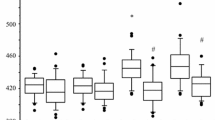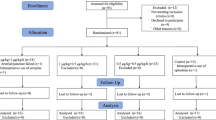Abstract
Background
Recent years have seen an increase in the use of dexmedetomidine in pediatric patients presenting for surgical procedures. However, only a limited number of studies have evaluated its effects on the QT interval in this patient group. To address this lack of knowledge, we have evaluated the effects of dexmedetomidine on the QT interval in children receiving sevoflurane anesthesia.
Methods
This study was a prospective case–control study in which pediatric patients presenting for anesthetic care were divided into two groups—the dexmedetomidine (D) and control (C) groups. Three electrocardiograms (ECGs) were obtained on each patient, including a baseline ECG (T1) prior to anesthetic induction and an ECG after the induction of anesthesia with sevoflurane (T2). In group D, the third ECG was obtained 2 min after the administration of dexmedetomidine, which in turn was started immediately after the T2 ECG reading (T3D); in group C, it was obtained 2 min after the T2 reading (T3C). Statistical analysis was performed using analysis of variance to compare the QT intervals at the three time points outlined above.
Results
A total of 50 patients were recruited to the study, ranging in age from 1 to 16 [mean 7.9 ± 4.1 (SD) years]. There were 25 patients in group C and 25 in group D. There were no statistical differences in the demographics between the 2 groups. In group C, the QTc was noted to increase progressively with the administration of sevoflurane (T3C vs. T1; P = 0.006). In group D, following the administration of dexmedetomidine, there was a significant decrease in the QTc relative to the post-induction value [436 ± 25 (T2) vs. 418 ± 17 ms (T3D); P < 0.01].
Conclusion
A progressive lengthening of the QTc interval following the administration of sevoflurane was observed in the control group. In the dexmedetomidine group, there was a significant shortening of the QTc interval following the administration of dexmedetomidine compared to the length of the post-induction QTc interval and when compared to the control group.
Similar content being viewed by others
References
Straus SM, Kors JA, De Bruin ML, van der Hooft CS, Hofman A, Heeringa J, Deckers JW, Kingma JH, Sturkenboom MC, Stricker BH, Witteman JC. Prolonged QTc interval and risk of sudden cardiac death in a population of older adults. J Am Coll Cardiol. 2006;47:362–7.
Panikkath R, Reinier K, Uy-Evanado A, Teodorescu C, Hattenhauer J, Mariani R, Gunson K, Jui J, Chugh SS. Prolonged Tpeak-to-Tend interval on the resting ECG is associated with increased risk of sudden cardiac death. Circ Arrhythm Electrophysiol. 2011;4:441–7.
Kim HS, Kim JT, Kim CS, Kim SD, Kim K, Yum MK. Effects of sevoflurane on QT parameters in children with congenital sensorineural hearing loss. Anaesthesia. 2009;64:3–8.
Kleinsasser A, Kuenszberg E, Loeckinger A, Keller C, Hoermann C, Lindner KH, Puehringer F. Sevoflurane, but not propofol, significantly prolongs the Q-T interval. Anesth Analg. 2000;90:25–7.
Kleinsasser A, Loeckinger A, Lindner KH, Keller C, Boehler M, Puehringer F. Reversing sevoflurane-associated Q-Tc prolongation by changing to propofol. Anaesthesia. 2001;56:248–50.
Neema PK. Dexmedetomidine in pediatric cardiac anesthesia. Ann Card Anaesth. 2012;15:177–9.
LeRiger M, Naguib A, Gallantowicz M, Tobias JD. Dexmedetomidine controls junctional ectopic tachycardia during Tetralogy of Fallot repair in an infant. Ann Card Anaesth. 2012;15:224–8.
Guo H, Takahashi S, Cho S, Hara T, Tomiyasu S, Sumikawa K. The effects of dexmedetomidine on left ventricular function during hypoxia and reoxygenation in isolated rat hearts. Anesth Analg. 2005;100:629–35.
Xu L, Hu Z, Shen J, McQuillan PM. Does dexmedetomidine have a cardiac protective effect during non-cardiac surgery? A randomised controlled trial. Clin Exp Pharmacol Physiol. 2014;41:879–83.
Hammer GB, Drover DR, Cao H, Jackson E, Williams GD, Ramamoorthy C, Van Hare GF, Niksch A, Dubin AM. The effects of dexmedetomidine on cardiac electrophysiology in children. Anesth Analg. 2008;106:79–83.
Chrysostomou C, Komarlu R, Lichtenstein S, Shiderly D, Arora G, Orr R, Wearden PD, Morell VO, Munoz R, Jooste EH. Electrocardiographic effects of dexmedetomidine in patients with congenital heart disease. Intensive Care Med. 2010;36:836–42.
Schwartz PJ, Garson A Jr, Paul T, Stramba-Badiale M, Vetter VL, Wren C. Guidelines for the interpretation of the neonatal electrocardiogram. A task force of the European Society of Cardiology. Eur Heart J. 2002;23:1329–44.
Chiladakis J, Kalogeropoulos A, Arvanitis P, Koutsogiannis N, Zagli F, Alexopoulos D. Preferred QT correction formula for the assessment of drug-induced QT interval prolongation. J Cardiovasc Electrophysiol. 2010;21:905–13.
Chiladakis J, Kalogeropoulos A, Arvanitis P, Koutsogiannis N, Zagli F, Alexopoulos D. Heart rate-dependence of QTc intervals assessed by different correction methods in patients with normal or prolonged repolarization. Pacing Clin Electrophysiol. 2010;33:553–60.
Wernicke JF, Faries D, Breitung R, Girod D. QT correction methods in children and adolescents. J Cardiovasc Electrophysiol. 2005;16:76–81.
Phan DQ, Silka MJ, Lan YT, Chang RK. Comparison of formulas for calculation of the corrected QT interval in infants and young children. J Pediatr. 2015;166:960–4.
Luo S, Michler K, Johnston P, Macfarlane PW. A comparison of commonly used QT correction formulae: the effect of heart rate on the QTc of normal ECGs. J Electrocardiol. 2004;37:81–90.
Burns KM, Greene EA. Long QT syndrome unmasked by dexmedetomidine: a case report. Congenit Heart Dis. 2014;9:E11–5.
Acknowledgment
This research was carried out without any funding. The GE Marquette MAC 5000 electrocardiograph used for the study was supplied free of charge by the pediatric cardiology department in Nationwide Children’s Hospital.
Author information
Authors and Affiliations
Corresponding author
Ethics declarations
Ethics
The study was approved by the Institutional Review Board of Nationwide Children’s Hospital, Columbus, Ohio (IRB13-00171), which waived requirements for informed consent due to the observational nature of the study, and registered at ClinicalTrials.gov (NCT01917786).
Conflict of interest
No author has a conflict of interest with regard to this study.
About this article
Cite this article
Kako, H., Krishna, S.G., Sebastian, R. et al. Effect of dexmedetomidine on the QT interval in pediatric patients undergoing general anesthesia. J Anesth 29, 862–867 (2015). https://doi.org/10.1007/s00540-015-2056-2
Received:
Accepted:
Published:
Issue Date:
DOI: https://doi.org/10.1007/s00540-015-2056-2




